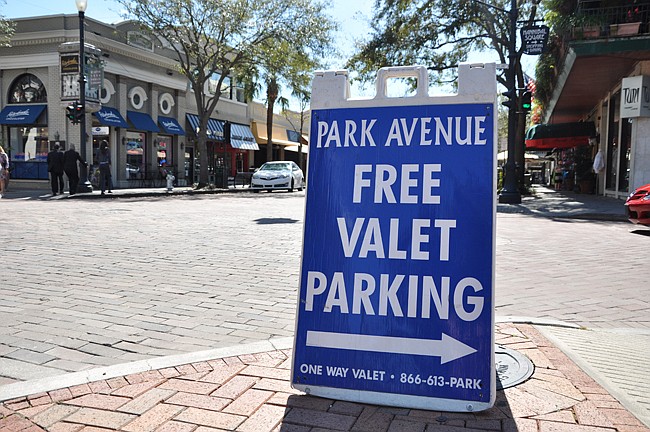- April 25, 2024
-
-
Loading

Loading

Drivers see them along major roads and residents spot them while strolling through downtown Winter Park: rampant signs upon signs – a blemish on the city’s aesthetic character, City Commissioners say.
The Winter Park City Commission discussed the issue of ‘sign pollution’ at their Feb. 24 meeting while considering an update to the city’s sign code, hoping to make code enforcement easier.
An ordinance drafted by attorney Catherine Reischmann with director of code enforcement James White proposes almost 100 different language changes to Winter Park’s sign code.
Revisions would include clearly prohibiting electronic signs, clarifying that residents are allowed to hold ‘free expression’ signs in public, and defining ‘animated signs’ – the prohibited practice of waving and spinning advertisements along city roads.
Foldable A-frame signs – often left along sidewalks by merchants on Park Avenue – must be within 2 feet of their respective businesses as well.
“We’re interested in seeing it be consistent,” White said.
“We do approach people who are aware of the ordinance and they go, ‘You really can’t prohibit us from doing this.’ Under the current [code] it is a little gray, so we’re going to make it pretty clear to everybody what’s going to be allowed and what’s not.”
The ordinance hopes to add several case law changes to the city’s sign code, which hasn’t been updated since 1976, Winter Park Planning Director Jeff Briggs said.
Updates would include allowing free expression signs of 4 square feet in all zoning districts and lifting the ban on placing election signs no sooner than 45 days prior to an election.
“We’re trying to capture a lot of different objectives in this ordinance,” said Bill Reischmann, a representative of the City Attorney’s office.
“A lot of laws have come out in the federal courts since our current code was constructed regarding signs.”
But the slew of revisions left Mayor Ken Bradley wondering whether the city was going too far – or perhaps not far enough.
“If I look and take the collective signs we have in Winter Park in all forms … it doesn’t feel like we have an ordinance,” Bradley said. “The term ‘mishmosh’ would come to mind.”
“In my opinion, the city is overrun with signs. That’s why I’m arguing for something even stronger than this.”
Winter Park’s code enforcement faces a daily struggle to rid the city of snipe signs – small advertisements stuck in the ground with metal prongs.
Major thoroughfares like U.S. Highway 17-92 are hotbeds for the signs, which are usually placed in large groups and range from foreclosure ads to yard sales notices.
Code enforcement officers will often finish a day with their pickup trucks completely filled with confiscated signs, White said.
One potential revision to the sign code would designate the snipe signs as ‘abandoned property,’ allowing residents to remove them without any legal repercussions.
“I see the snipe signs – they’re like mushrooms,” Commissioner Tom McMacken said. “They’re there one day and gone the next and there’s another batch up and down even the small streets that I drive, not the main thoroughfares.”
Winter Park should attempt to emulate cities like Boca Raton and Port Orange, who have an appearance of far less signage, Bradley said.
The perceived lack of sign code enforcement comes from the mix of varying temporary signs, particularly along Park Avenue, Briggs said.
“It’s the mishmosh of the A-frame signs – some are very professionally done and some of them are crude with letters of all different sizes and colors and all different locations,” Briggs said. “I think the single most important thing we could do if we wanted to … is get rid of all those A-frame portable signs. They’re a constant headache for enforcement.”
“Now there’s an entitlement to them if you’re a business owner, so it’s very difficult to take something away.”
Commissioner Carolyn Cooper was hesitant with a number of the proposed revisions, which she felt added to the city’s issue with sign clutter. One revision would increase the maximum number of election signs allowed in front of homes from two to four.
Office signs along Lee Road would be allowed to expand from 36 square feet to 50 square feet as well, while church signs would be bumped up from 18 square feet to 24 square feet.
“In so many places we’re increasing the size of all the signs that we currently allow,” Cooper said.
“We have sign clutter. We have sign pollution and there’s no doubt about it.”
Hundreds of current businesses abiding by the out-of-date code means it could take decades for the city to get signs where they want them to be, Bradley said.
Reischmann suggested exempting current businesses from the new revisions, but said that signs moving forward could be regulated by size, amount and specific location. Though the ordinance would have to be content neutral as not to inhibit free speech.
“If somebody is for or against something, I’m very hesitant to attempt to legislate that in any way, shape or form,” Bradley said. “That’s part of our – in my opinion – constitutional rights.”
“I don’t know that every business and every strip mall has to have a sign though.”
City Commissioners voted to table the item and discuss it at a future work session.